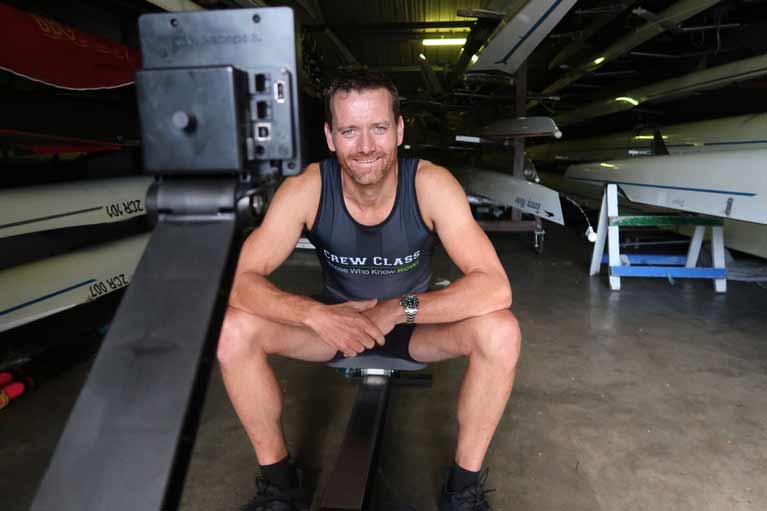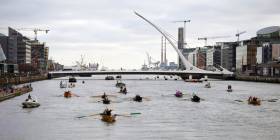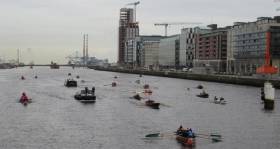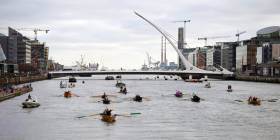Displaying items by tag: All in a Row
‘All in a Row’ Marathon Charity Challenge on River Liffey Aims to Break 1,000km Rowing Target
The ‘All in a Row’ charity challenge for 2022 is coming to the Dublin’s River Liffey on Saturday 3 December with teams looking to smash a target of 1,000km rowed in eight hours.
Forty skiffs, four Dragon boats, kayaks, canoes and currachs will all be on the water to raise funds for RNLI lifeboats and the Irish Underwater Search and Recovery Unit.
Organisers are hoping to exceed last year’s target of rowing 1,000km during the event on the river, which will start from St Patrick’s Rowing Club at the Tom Clarke Bridge (formerly the East Link Bridge) and finish at the Ha’penny Bridge.
The challenge is being undertaken with the aim of showcasing the River Liffey as one of Dublin’s best amenities while raising funds for two vital water-related charities. The event raised €20,000 in 2021.
The action gets under way start from 8.30am on Saturday 3 December and at 1pm all boats will gather on the Liffey at the Sean O’Casey footbridge where wreath-laying ceremony, attended by the Deputy Lord Mayor of Dublin, will take place to commemorate all those who have lost their lives through drowning.
Many Dublin rowing clubs have their home on the River Liffey and are a regular sight on the water. At the port end of the river is St Patrick’s Rowing Club, Stella Maris Rowing Club, East Wall Water Sports Group and Poolbeg Yacht and Boat club. Ringsend Basin is home to the Plurabelle Paddlers (Dragon boats) and the Dublin Viking Dragon boats.
At the other end of the city, beyond Heuston Station, there are many river rowing clubs and kayaking clubs including Phoenix Rowing Club. And rowing clubs from other parts of Ireland will also join in the challenge.
Competitors are asked to raise sponsorship for the event, and for spectators and supporters there is an iDonate page where one can give towards two very worthy water safety and rescue causes.
There was a Lffeyside handover on Friday of the 'All in a Row' cheque of €13,000 raised in aid of the Irish Refugee Council at the Poolbeg Yacht and Boat Club in Ringsend, Dublin.
The much-needed funds raised came from May's Charity Concert featuring Phelim Drew and House Band and will go towards the needs of Ukrainian children who sadly arrived in Ireland without parents this year.
‘All in a Row’ Marathon Charity Challenge on Dublin’s River Liffey Provides A Great Boat Show Afloat
When we revealed the background to the Crosshaven-built George Bushe rowing skiff Lorelei of 1954 vintage, many sailors of traditional outlook could have been forgiven for reckoning this innovative craft would still stand out as decidedly unusual in any gathering of skiffs.
But these days, after a period when designers of the calibre of Rob Jacob of Kinsale have turned their skills to making the best of the Coastal Rowing Hull Rules, there are some decidedly advanced craft afloat. And at last weekend’s All In A Row challenge in Dublin the Lorelei - which thanks to Darryl Hughes of the Dublin Bay Old Gaffers Association is now in the charge of the Stella Maris Rowing Club of Ringsend - was just one of many exotics, some of them very exotic indeed, in a fleet which took in several traditional types, including a good turnout of the classic coastal skiffs as used in times past by the Dublin Bay hobblers.
 “The end is in the beginning and yet you go on…..” The fleet coming through the Sam Beckett Bridge evokes the thought of a quote from the Nobel Laureate
“The end is in the beginning and yet you go on…..” The fleet coming through the Sam Beckett Bridge evokes the thought of a quote from the Nobel Laureate
 The functional beauty of a classic coastal skiff, as used in times long past by the hobblers of Dublin Bay to take pilots to incoming ships
The functional beauty of a classic coastal skiff, as used in times long past by the hobblers of Dublin Bay to take pilots to incoming ships
‘All In A Row 2021’ on Saturday was a challenge for the teams to smash a 1,000km target in eight hours. Forty skiffs, kayaks, canoes and currachs were on the water to raise funds for the RNLI and the Irish Underwater Search and Recovery Unit.
The event started from St. Patrick’s Rowing Club at the Tom Clarke Bridge (formerly the East Link Bridge) and rowers turned at the Ha’penny Bridge, before rowing back down river to the Tom Clarke Bridge. This annual challenge is undertaken with the aim of showcasing the River Liffey as one of Dublin’s best amenities, while raising funds for the water-related charities, RNLI Lifeboats and the Irish Underwater Search and Recovery Unit. The event raised in excess of €12,000.
 “This is no job for sissies…..” The Stella Maris club’s junior team put their shoulders into it.
“This is no job for sissies…..” The Stella Maris club’s junior team put their shoulders into it. By contrast, a very effort-economical machine, complete with an offshore racer’s retroussé transom and sugar-scoop stern. You might well think of fitting a sailing rig…..
By contrast, a very effort-economical machine, complete with an offshore racer’s retroussé transom and sugar-scoop stern. You might well think of fitting a sailing rig…..
At 1 pm all the boats gathered on the Liffey at the Sean O’Casey footbridge where a wreath-laying ceremony, attended by the Lord Mayor of Dublin, Alison Gilliland, took place to commemorate all those who have lost their lives through drowning.
The Lord Mayor said: “The River Liffey is such an important part of the city of Dublin, and it is wonderful to see so many people using and enjoying the river in this range of skiffs, kayaks, canoes and currachs. Best of luck to all those taking part today, and well done for rising to the challenge of rowing 1,000 km, showcasing our beautiful river and raising money for two great water related charities, RNLI Lifeboats and the Irish Underwater Search and Recovery Unit.”
 Is there room at the Inn? Seasonable re-enactment by Anne Marie Scully, Derek Kellett, Linda Byron (President of Canoeing Ireland) and Eamonn Duffy
Is there room at the Inn? Seasonable re-enactment by Anne Marie Scully, Derek Kellett, Linda Byron (President of Canoeing Ireland) and Eamonn Duffy
Many Dublin rowing clubs have their home on the River Liffey and are a regular sight on the water. At the port end of the river is St. Patrick’s Rowing Club, Stella Maris Rowing Club, East Wall Water Sports Group and Poolbeg Yacht and Boat club. Ringsend Basin is home to the Plurabelle Paddlers (dragon boats) and the Dublin Viking Dragon boats. At the other end of the city beyond Heuston Station, there are many river rowing clubs and kayaking clubs, including Phoenix Rowing Club. Rowing clubs from other parts of Ireland are joining in this ongoing challenge to raise funds for RNLI Lifeboats and the Irish Underwater Search and Recovery Unit.
Competitors were asked to raise sponsorship for the event, and also for spectators and supporters, there is a GoFundMe page for donations here
The Irish Underwater Search and Recovery Unit
The Irish Underwater Search and Recovery Unit (“IUSRU”) is a charity registered in the Republic of Ireland under charity number, CHY20132.
When people go missing on rivers, canals, lakes or around our coasts they go beyond the reach of the public and require specialist equipment and personnel to bring them home, and the IUSRU (founded 2012) is made up of a dedicated team of volunteers who’s objective is to search for missing people underwater and recover them for their families and friends so they can be given a dignified resting place.
 It became a living Boat Show Afloat in the heart of Dublin
It became a living Boat Show Afloat in the heart of Dublin
RNLI Lifeboats
The RNLI’s volunteers operate a 24-hour search and rescue operation 100 nautical miles out from the coast of Ireland and the UK. There are 46 lifeboat stations in Ireland, four of which are inland at Carrybridge, Enniskillen, Lough Ree and Lough Derg. There are three lifeboat stations in Dublin at Howth, Dun Laoghaire and Skerries.
In 2020, Irish lifeboats launched 945 times bringing 1,147 people to safety.
The charity’s vision is to end preventable loss of life at sea. 95% of the RNLI’s people are volunteers. In Ireland there are approximately 1,000 volunteer lifeboat crew, and over 2,000 volunteer community fundraisers as well as many other dedicated volunteers who raise awareness, give safety advice and help out in RNLI shops and offices.
 The Stella Maris crew expressing the sheer joy of rowing an easily-moved boat as they shift Lorelei up the Liffey at Ringsend.
The Stella Maris crew expressing the sheer joy of rowing an easily-moved boat as they shift Lorelei up the Liffey at Ringsend.
Skiff Racing a Knockout for Former World Champion
Niall O’Toole, the first Ireland world champion in Olympic-class rowing who now runs indoor rowing courses, remembers fondly how he was invited to race in a boat class that goes back over a century.
Cracking the Code of East Coast Skiff Racing
By Niall O’Toole
It was a dreary November night. A green army of St. Patrick’s singlets filed into the room. I wanted to make a good first impression before our first indoor rowing session began. I proceeded to introduce myself. “Hi Guys, I’m Niall O’Toole, three-time Olympian, world champion, former world record holder and multi world medallist”. A deadly silence swept through the room. I didn’t hear any expletives, but their faces said it all.
Three months passed before there was any glimmer of recovery. Then, came the request: “Would you like to race skiffs, Niallo?”. I expected to go through a data-driven, seat-racing selection process, but discovered that crew selection was considered more an art form than a science. In quiet corners, canny, skiff insiders decide the fates of crews, as they have done since the late 19th Century, where the tradition of ‘Hobbling’ first began. Back then skiffs raced for piloting rights to cargo ships. Now the tradition of racing skiffs continues. So it was that I joined my first skiff crew and started training.
 Niall O’Toole
Niall O’Toole
The first thing I noticed was the beauty of the boats. I was used to brittle carbon fibre Olympic missiles, built to specific weights and criteria, which seem dull and lifeless by comparison. Skiffs are living, breathing works of craft, ever-changing over time and lovingly maintained by obsessive boatmen; men like my late father Jimmy O’Toole. He was a shipwright for Guinness on the Lady Patricia, which brought crates of the black stuff to Liverpool. He built and repaired many wooden boats in his time, including one in the back garden of our terraced house, which turned out to be too big to get out. Fifteen hedges, fences and brick walls later, he slotted it out through a break between two houses.
Being surrounded by wooden boats again brought back fond memories of my Dad. I’m still none the wiser about what clubs deem a ‘fast’ or ‘slow’ boat’, though.
Crews grow comfortably accustomed to their skiff’s quirks, and are suspicious of change. A new boat into the club can find itself labelled ‘slow’ and relegated to life on a rack. The mythology around oars is unique too – no two wooden oars are exactly the same. Weight, stiffness, size of blade, handle-width and grip all play into making the perfect oar for any one individual’s taste. It took me weeks to find an oar that gripped the water the way I liked. I marked it with tape to make it easy to find again, but found that tape is easily removed and an oar easily hidden. I’ve seen many a ruckus on the dock over an oar that found itself favoured by two crews.
My first race for St Pat’s was in Dun Laoghaire. A stalwart of the club, Philip Murphy, whispered in my ear: “It’s rough out there Tooler! Make sure you get water.” I wasn’t sure what he meant. Due to the rise and fall of the boat, it was impossible to adjust your hand position enough to stay in contact with the water. Pulling air doesn’t give you boat speed, but we managed to lead the race into the first turn.
Prematurely, I saw myself adding another notch to my glittering rowing career, when amidst the whirlwind of cox’s screams, burning lungs, and the strength-sapping manoeuver of trying to use my oar as a handbrake to swing the boat around, we exited the turn in second-last place. We tried to pick up the pace, but the water was just too big to make up any of the ground we’d lost. Then we rounded the second buoy to find a rogue skiff on a bad line coming straight for us. I ducked and heard an almighty crack. ‘Skipper’, my crewmate, was clocked with an oar to the head and knocked clean out, hitting the bottom of the boat with a thud. Stuff like that just never happens at the Olympics!
I spent the next couple of months learning the subtleties of the sport; learning the craft, culture and code. It’s not all about straight-line speed - you do need to be fit and fast, but it’s also about currents, streams, winds, waves, tides and a little help from lady luck. It’s about your cox finding the fastest racing line and your crew communicating around the turn with their lungs on fire. I came to realise that the physical exertion and pain you feel in skiff racing is every bit as tough as the Olympic sport I know. Most importantly, I learnt that St. Pat’s is truly a community based club; in that humble old Dublin, no-nonsense kind of way. In a club where people truly look out for each another, I found a warm welcome, a sense of place and lifelong friends. In the twilight of my rowing career, I had no idea that was possible.
The All In A Row charity event will be held on the Liffey on Saturday, November 30th. Rowing, kayak and canoe clubs along with private rowing boat owners can be part of a 10-hour row/paddle to raise money for both the RNLI and The Irish Underwater Search and Recovery Unit. The boats will travel from St Patrick’s Rowing Club at Tom Clarke Bridge (formerly East Link Bridge) to Heuston Station Bridge and to the Grattan Bridge during high tide. During low tide it can be viewed along the banks of the Liffey.
Mammoth Eight-Hour Rowing Challenge On River Liffey Will Raise Funds For Charities
All In A Row 2018 comes to the River Liffey this Saturday 1 December, challenging teams rowing 40 skiffs, kayaks, canoes and currachs to exceed a 1,000km target in eight hours.
The organisers are hoping to beat last year’s target during the event from St Patrick’s Rowing Club at the Tom Clarke Bridge (formerly the East-Link Bridge) and finishing at the Ha’penny Bridge.
While showcasing the River Liffey as one of Dublin’s best amenities, the challenge also aims to raise funds for water-related charities, namely the RNLI and the Irish Underwater Search and Recovery Unit.
The event will start at 8am this Saturday and at noon all boats will gather in front of the Sean O’Casey footbridge. A wreath-laying ceremony, attended by the Lord Mayor of Dublin Nial Ring, will also take place to commemorate all those who have lost their lives through drowning.
The event remembers particularly the crew of the currach rowed and sailed from the Liffey to Santiago de Compostela and who later lost a valued crew member in Danny Sheehy.
The RNLI will have an Atlantic 85 inshore lifeboat on display for people to view during the day, berthed alongside the Jeanie Johnston replica famine ship.
The event is also being used as an opportunity to engage with inner city Dublin schools whose pupils have been invited to the Dublin Docklands offices to learn about water safety through the RNLI’s Respect the Water campaign, and how they can volunteer in their communities to help save lives at sea. The city’s Sea Scouts will also be participating in the event.
Many Dublin rowing clubs have their home on the River Liffey and are a regular sight on the water. At the port end of the river is St Patrick’s Rowing Club, Stella Maris Rowing Club, East Wall Water Sports Group and Poolbeg Yacht and Boat Club.
Ringsend Basin is home to the Plurabelle Paddlers (Dragon boats) and the Dublin Viking Dragon boat club. At the other end of the city, beyond Heuston Station, there are many river rowing clubs and kayaking clubs, including Phoenix Rowing Club.
This Saturday the many boating clubs of the Liffey will be joined by rowing clubs from other parts of Ireland.
“Everyone knows the River Liffey but most people don’t know how far it stretches and how many rowing groups use it regularly,” organisers said.
“There is a vibrant boating community on the River Liffey and these clubs regard it as the living artery of the city and one of Dublin’s great and undervalued amenities.
“After the beautiful summer we’ve had, we know that people are drawn to the water, whether on the coast or inland to enjoy different water sports.
“The Liffey is an undervalued and underused resource that is right under people’s noses and we want to encourage them to use it and to use it safely. From school children right up to seasoned rowers, this is a great opportunity to draw people down to the Liffey and learn about water safety and the fun activities they can do on the water all year round.”
Competitors are asked to raise sponsorship for the event, and for those not competing and supporters, there is a GoFundMe page for donations.
All-in-a-Row Funds Handed Over to Charities
#GoodDeed: Two cheques were handed over to the RNLI and The Irish Underwater Search and Recovery Unit at a special event at the weekend. The funds were collected through the All in a Row charity event on the Liffey in December. More than 40 boats turned out and the €12,960 which was raised was evenly divided between the two charities.
The cheques were presented to the deserving causes on Friday in Poolbeg Yacht and Boat Club by special guest Sean O’Donoghue, a deep sea diver on the infamous Piper Alpha oil rig which exploded 30 years ago this July. The incident caused the deaths of 167 men. Sean O’Donoghue was involved in the search for and recovery of those men.
The organisers of the All in a Row event are very grateful to those who took part and those who donated so generously.
Charities Benefit as Flotilla Takes to Liffey This Saturday
#Rowing: The second annual All-in-a-Row charity event on the River Liffey will be held this Saturday, December 9th. Rowers, kayakers and canoeists will take part in a row or paddle to raise money for the RNLI and The Irish Underwater Search and Recovery Unit. The course runs from the Tom Clarke Bridge (formerly the East Link) to Grattan Bridge, and the event will start at 8 am and end at 3.30. There will be a base at St Patrick’s Rowing Club.
There is a link for those who wish to donate on allinarow.ie.
The RNLI provides a rescue service at sea, along with education and supervision on beaches. It sets out to influence other organisations, policy-makers and regulators, throughout Ireland, England, Scotland and Wales. The RNLI provides a 24-hour search and rescue service to 100 nautical miles out from the coast of Ireland and the UK.
Ninety five per cent of RNLI people are volunteers. RNLI crews and lifeguards have saved over 142,000 lives since the institution was formed in 1824. They have 46 Lifeboat stations around the Republic of Ireland and Northern Ireland and four inland lifeboat stations, at Lough Derg, Lough Ree, Lough Erne and Strangford Lough.
RNLI statistics (2016): 1,136 launches; 1,649 people rescued; 37 lives saved; on average 28 people rescued per week.
The Irish Underwater Search and Recovery Unit (IUSRU) is a charity registered in the Republic of Ireland.
When persons go missing in rivers, canals, lakes or around our coasts they require specialist equipment and personnel to bring them home. The IUSRU is made up of a dedicated team of volunteers who search for missing people underwater and recover them so they can be given a dignified resting place.
The IUSRU was formed in January 2012 to provide a professional, dedicated and highly trained service that could carry out the task of recovering missing persons with compassion and sensitivity.
In 2014 there were 114 recorded deaths through drowning in Ireland.
































































